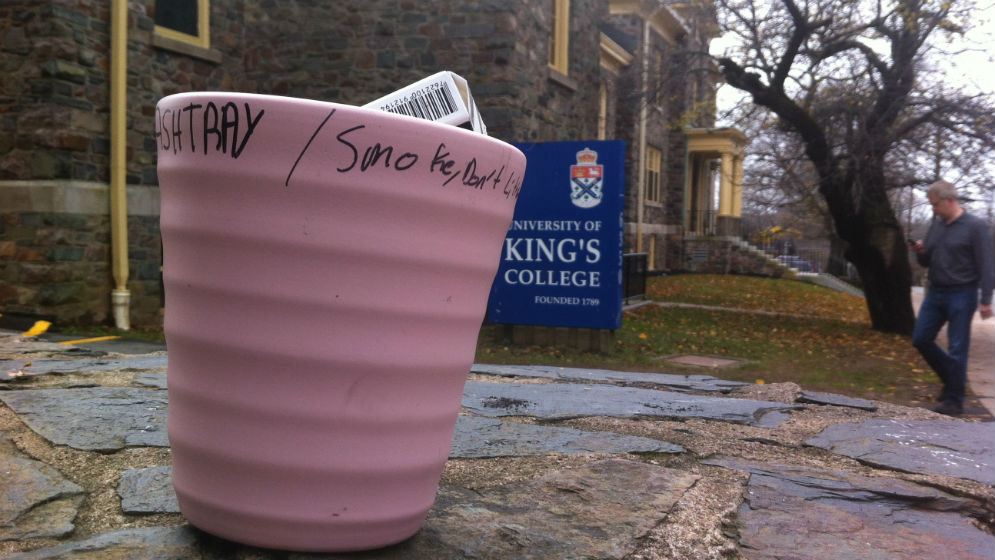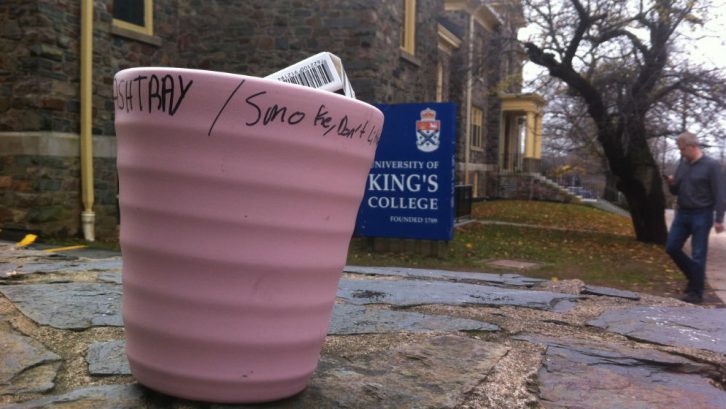Health
Nova Scotia second in smoking rates, national survey says
Smoking rates have declined only 1.6 per cent since 2013

caption
Banned from smoking on campus, smokers use this makeshift ashtray during cigarette breaks.
caption
Banned from smoking on campus, smokers use this makeshift ashtray at the University of King’s College.Nova Scotians aren’t kicking their smoking habits as much as other Canadians, despite the province’s leadership role in anti-smoking initiatives.
The biennial Canadian Tobacco, Alcohol and Drugs Survey (CTADS) found that 17.8 per cent of Nova Scotians are smokers. This makes Nova Scotia the second-highest for smoking rates in the country. Nationally, the rate is 13 per cent. Nova Scotia also has the highest rate of smokers between the ages of 25 and 44 in the country.
“We’ve historically had some of the highest rates in the country,” says Dr. Robert Strang, chief public health officer for the Province of Nova Scotia, who is quick to point out a dramatic decline from smoking rates at the turn of the century.
In 2000, the smoking rate in Nova Scotia was the highest in the country, almost double the current rate, at 29.8 per cent.
Although there was a 1.6 per cent decline in Nova Scotia’s smoking rates from the 2013 CTADS, this is statistically insignificant, says Robert MacDonald, director of health initiatives for The Lung Association of Nova Scotia.
“We’ve plateaued for the last decade,” he says.
Neither MacDonald nor Strang could pinpoint why provincial rates continue to be high, though both said that people with low socioeconomic status continue to have a high prevalence toward smoking, despite the cost of cigarettes. Today, a pack of cigarettes in Nova Scotia varies from the $12 range for value brands to over $18 for a premium brand.
“Taxation is still the No. 1 policy decision that will drastically affect smoking rates,” MacDonald says. “It doesn’t add up other than, you know, are these people making decisions to smoke rather than take care of basic needs whether it’s… food, clothing or shelter?”
Strang says he can only speculate why smoking is still pervasive in low income populations, suggesting that people may prioritize dealing with other issues and stresses rather than focusing on quitting smoking.
Although anti-smoking legislation is decided by individual provinces and municipalities, laws are generally consistent across the country.
“We’ve all made the same progress,” Strang says.
Nova Scotia has also been a leader with anti-smoking initiatives. In 2006, it was one of the first provinces to ban smoking in indoor public places. Two years later, Nova Scotia was the first province to ban smoking in cars when children are present and in 2015, it was was the first place in the world to ban the sale of flavoured tobacco products.
The province with the highest smoking rate, according to CTADS, is Newfoundland and Labrador at 18.4 per cent. The lowest is British Columbia at 10.2 per cent.
Strang says that this could be attributed to British Columbia’s strong record of public health initiatives, as well as lifestyle differences on the west coast. He also notes that Canada’s national goal is “five by 35,” or having a five per cent smoking rate across the country by the year 2035.
This fall a conference about strategies for what public health experts call the cigarette “endgame” was hosted at Queen’s University in Kingston, Ont. MacDonald says a similar “endgame” conference is being planned in Nova Scotia next year to discuss the issue on a provincial level.
The Canadian Tobacco, Alcohol and Drugs Survey comes out every two years and 1,437 Nova Scotians participated in the most recent survey.
In Nova Scotia smoking cessation resources can be accessed by calling 811 or by visiting https://tobaccofree.novascotia.ca/.
